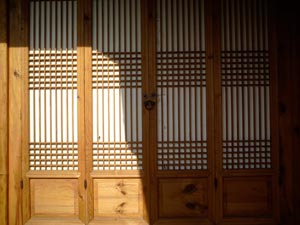 |
 |
My family had a barbecue the other night. A coal-fired grill sat in the center of the courtyard, my son on my lap and a bottle of soju nearby as we stared at the moon hanging above the tiled roof of the neighboring hanok. I told him about the rabbit who makes rice cakes up there. He sat wide-eyed, face aglow above the burning coal. It was timeless.
We moved to Gahoedong about a month ago, after spending a year in a remote corner of southeast Seoul in an enormous house we were renting from a friend. Surrounded by mountains and with an expansive yard, the place was truly palatial, but I felt cut-off somehow. I'd come home from work, close the door, then close another, and another.
Our new home is tiny in comparison, barely 18 pyung. Three square rooms in a straight row separated by sliding paper doors. There are no divides other than these, no space where I can shut out the world. Wherever I am in the house, I can either see or hear my son. I feel closer to my family here.
In Korean there is a word that I have yet to find a perfect translation for. Pronounced 'jung', it expresses a certain closeness, a bond or loyalty, even warmth, that ideally exists between people. I think traditional Korean homes were designed with this trait in mind. Of course they were also separated along social and gender lines, with male and female, or master and servant, designated clearly marked quarters. But even these architectural divisions seem to blend into one another, like the sloping roofs that follow the contours of the mountains in the distance.
There is a spiritual quality to the design of a hanok. While keeping out the elements, particularly the biting winter cold, they are also permeable in that nature seems to bleed into them. With the wooden beams and clay walls, it seems almost as if they sprouted out of the ground on which they sit. They were made with an eye to harmony that transcends aesthetics.
Hanoks come in different shapes and sizes, resembling the letters of the Korean alphabet. Some are L-shaped, others resemble a square shaped mouth. All have courtyards. Ours is shaped like the Chinese character for the number 1 - a simple horizontal line - with a newer bathroom and kitchen added on to either end, and of course a courtyard in the center, a sort of extra room with a view of the heavens.
As the nation careened into the modern era, hanoks became equated by a majority of Koreans as a sign of backwardness, their squat frames disdained for the newer rows of apartment blocks that now pollute the skyline in all of Korea's major cities. Under Gen. Park Jung-hee, who ruled the country for 30 years under a policy of forced modernization, a disturbingly large portion of Korea's cultural heritage was destroyed, from archaeological remains to architectural treasures. With the exception of the city of Kyongju and a small pocket in Seoul, Korea's hanoks never stood a chance.
Yet not all the blame lies with the government. A neighbor who recently purchased a hanok not far from our own invited us over to see her place. She showed us the damage done to the house - built over 90 years ago she says - through the neglect of its previous owner, who by the looks of it made a half-hearted attempt to modernize the building. The result was a sort of patchwork of concrete and wood, with bathroom tiles laid in all the wrong places.
A walk through the neighborhood reveals that the remaining hanoks are all in various stages of upkeep. Some are resplendent, like proud sentries bedecked in their finest. Others are barely hanging on, dilapidated shells of their former selves. Many are just gone, replaced by brick and mortar "villas" that promise a greater return on property values but literally squeeze the life out of the hanoks on either side.
Still, the area is undergoing a sort of renaissance as streams of Japanese tourists and young couples increasingly ply the narrow byways enjoying the rustic atmosphere, taking in a sea of tiled roofs that gently curve their way down to the skyscrapers below. Likely they know little of the struggles that went on recently to save what was left of the old houses, the corrupt bureaucrats and greedy developers who systematically swallowed up a majority of the original buildings.
But on their faces is reflected the beauty of these humble reminders of Korea’s past. And who knows, maybe that will be enough to stymie even the worst laid plans.
Peter Schurmann
Seoul, March 5th 2009
http://www.kahoidong.com
Contact
us
![]()